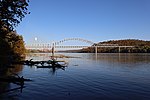Miami Fort Power Station
Buildings and structures in Hamilton County, OhioCoal-fired power stations in OhioEnergy infrastructure completed in 1949Energy infrastructure completed in 1960Energy infrastructure completed in 1971 ... and 5 more
Energy infrastructure completed in 1975Energy infrastructure completed in 1978United States power station stubsUse mdy dates from October 2011Vistra Corp

The Miami Fort Generating Station is a dual-fuel power generating facility. It is a major coal-fired electrical power station, supplemented with a small oil-fired facility. Miami Fort is located in Miami Township, Hamilton County, immediately east of the tripoint of Indiana, Kentucky, and Ohio. Miami Fort Station is named for the nearby Miami Fort (not to be confused with Fort Miami in the same state).
Excerpt from the Wikipedia article Miami Fort Power Station (License: CC BY-SA 3.0, Authors, Images).Miami Fort Power Station
Brower Road, Miami Township
Geographical coordinates (GPS) Address Nearby Places Show on map
Geographical coordinates (GPS)
| Latitude | Longitude |
|---|---|
| N 39.115555555556 ° | E -84.805 ° |
Address
Brower Road
Brower Road
45052 Miami Township
Ohio, United States
Open on Google Maps





